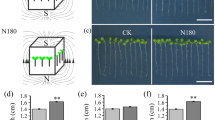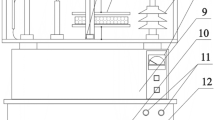Abstract
ACCORDING to Duclaux1, Pasteur explored the possibility of the effect of a magnetic field on the production of optical isomers of tartaric acid. He theorized that the Earth's magnetic field caused tartaric acid to be of one optical isomer in nature, whereas laboratory synthesis produced a mixture of both isomers. Recently, Krylov and Tarakonova2 proposed an auxin-like effect of a magnetic field on germinating seeds. They called this effect magnetotropism. Auxins or, synthetic plant growth regulators have been used to stimulate ripening of immature fruits3.
This is a preview of subscription content, access via your institution
Access options
Subscribe to this journal
Receive 51 print issues and online access
$199.00 per year
only $3.90 per issue
Buy this article
- Purchase on Springer Link
- Instant access to full article PDF
Prices may be subject to local taxes which are calculated during checkout
Similar content being viewed by others
References
Duclaux, D., Pasteur, The History of a Mind, 29 (Saunders, Philadelphia, 1920).
Krylov, A. V., and Tarakonova, G. A., Plant Physiol. (Fiziologiia Rostenii), 7, 156 (1960).
Hartman, R. T., Plant Physiol., 34, 65 (1959).
Pauling, L., and Coryell, C. D., Proc. U.S. Nat. Acad. Sci., 22, 159 (1963).
Smith, M. J., and Cook, E. S., Chem. Eng., 44 (1963).
Author information
Authors and Affiliations
Rights and permissions
About this article
Cite this article
BOE, A., SALUNKHE, D. Effects of Magnetic Fields on Tomato Ripening. Nature 199, 91–92 (1963). https://doi.org/10.1038/199091a0
Issue Date:
DOI: https://doi.org/10.1038/199091a0
This article is cited by
-
Magnetoreception in plants
Journal of Plant Research (2005)
-
Mechanism of Plant-Cell Damage in an Electrostatic Field
Nature (1964)
Comments
By submitting a comment you agree to abide by our Terms and Community Guidelines. If you find something abusive or that does not comply with our terms or guidelines please flag it as inappropriate.



